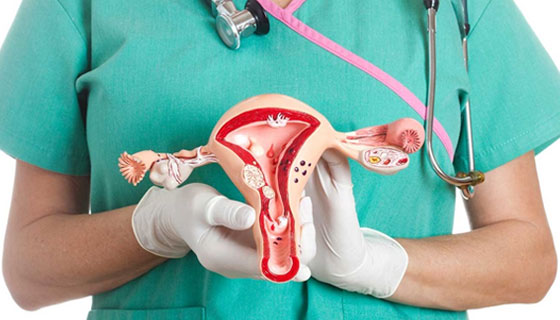
Laparoscopic Hysterectomy Surgery
A hysterectomy is a surgical procedure that removes your uterus. After surgery, you can’t become pregnant and no longer menstruate. Reasons for this surgery include abnormal bleeding, uterine prolapse, fibroids. Recovery usually takes four to six weeks, depending on the type of surgery you have.
What are the different kinds of hysterectomy?
Your healthcare provider will discuss which type of hysterectomy is needed depending on your condition. This will determine if your fallopian tubes and/or ovaries need to be removed.
- Total hysterectomy: Removing your uterus and cervix, but leaving your ovaries.
- Supracervical hysterectomy: Removing just the upper part of your uterus while leaving your cervix.
- Total hysterectomy with bilateral salpingo-oophorectomy: Removing your uterus, cervix, fallopian tubes (salpingectomy) and ovaries (oophorectomy). If you haven't experienced menopause, removing your ovaries will start menopausal symptoms.
- Radical hysterectomy with bilateral salpingo-oophorectomy: The removal of your uterus, cervix, fallopian tubes, ovaries, the upper portion of your vagina and some surrounding tissue and lymph nodes. This type of hysterectomy is performed when cancer is involved.
Why is a hysterectomy performed?
Healthcare providers perform hysterectomies to treat:
- Abnormal or heavy vaginal bleeding that isn’t managed by other treatment methods.
- Severe pain with menses that isn’t managed by other treatment methods
- Leiomyomas or uterine fibroids
- Increased pelvic pain related to your uterus but not managed by other treatments.
- Uterine prolapse (uterus that has “dropped” into your vaginal canal due to weakened support muscles) that can lead to urinary incontinence or difficulty with bowel movements.
- Cervical or uterine cancer or abnormalities that may lead to cancer for cancer prevention.
- Conditions with the lining of your uterus, like hyperplasia, recurrent uterine polyps or adenomyosis.
How common is it to get a hysterectomy?
About 300,000 women get hysterectomies in the United States each year. It’s the second most common surgery performed among women (after Cesarean section).
How do I prepare for a hysterectomy?
A healthcare provider will explain the procedure in detail, including possible complications and side effects. Talk to them about any concerns you have. You may be asked to provide blood and urine samples.
What happens during a hysterectomy?
Your healthcare provider will determine the type of hysterectomy you need and the best surgical method to perform that procedure. You’ll change into a hospital gown and get hooked up to monitors that track your heart rate. An intravenous (IV) line is placed in a vein in your arm to deliver medications and fluids.
An anesthesiologist will give you either:
- General anaesthesia, in which you won’t be awake during the procedure; or
- Regional anaesthesia (also called epidural or spinal anaesthesia), in which medications are placed near the nerves in your lower back to “block” pain while you stay awake.
There are several different surgical approaches your healthcare provider may use to perform a hysterectomy:
Vaginal hysterectomy
- Your uterus is removed through an incision at the top of your vagina. There isn’t an external incision.
- Dissolvable stitches are placed inside your vagina.
- Most commonly used in cases of uterine prolapse and other nonmalignant conditions.
- Fewest complications and fastest recovery (up to four weeks) and considered the preferred approach.
- People often go home on the same day of surgery.
Laparoscopic hysterectomy
- A laparoscope (a thin tube with a video camera on the end) is inserted in your lower abdomen through a small incision in your belly button.
- Surgical tools are inserted through several other small incisions.
- Your uterus can be removed in small pieces through the incisions in your abdomen or through your vagina.
- Some people go home the same day or after one night in the hospital.
- Full recovery is shorter and less painful than an abdominal hysterectomy.
Robotic-assisted laparoscopic hysterectomy
- Your surgeon performs the procedure with the help of a robotic machine.
- A laparoscope is inserted in your abdomen so your pelvic area can be viewed.
- Small, thin surgical tools are inserted through three to five incisions around your belly button. Robotic arms and instruments are controlled by the surgeon.
- The recovery is similar to a laparoscopic hysterectomy.
Abdominal hysterectomy
- Your uterus is removed through a six- to eight-inch-long incision in your abdomen.
- The incision is made either from your belly button to your pubic bone or across the top of your public hairline. The surgeon will use stitches or staples to close the incision.
- It generally requires a longer hospital stay (two or three days) and a longer recovery time.
What happens after a hysterectomy?
The amount of time you spend in the hospital following a hysterectomy varies depending on what kind of surgery you had. Your healthcare provider will want to monitor you and ensure there aren’t any signs of complications like blood clots or bleeding. You’ll walk around as soon as possible after your surgery to prevent blood clots in your legs.
If you had an abdominal hysterectomy, you might stay in the hospital for a few days. Vaginal and laparoscopic hysterectomies are less invasive and typically don’t require an overnight stay in the hospital.
Your healthcare provider will go over recovery instructions, including restrictions to your day-to-day activities. Be sure to discuss any concerns you have about your recovery or the procedure.
How long does it take to recover from a hysterectomy?
Most people recover from a hysterectomy in about four to six weeks. Your recovery depends on the type of hysterectomy you had and how the surgery was performed. Recovering from a vaginal and laparoscopic hysterectomy takes less time than recovering from an abdominal hysterectomy.
You should increase your activity gradually and pay attention to how you feel. If anything causes you pain, you should stop. Talk to your healthcare provider about specific instructions for recovering at home, including what medications to take.
When you come in for a consultation with one of Chawla Nursing Home’s doctors, you will be given information about all your options. Schedule your appointment today.
Schedule An Appointment
Get your Appointment Confirm with us Easily

